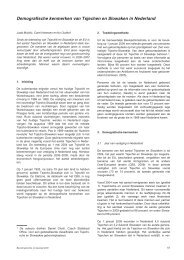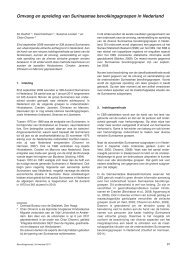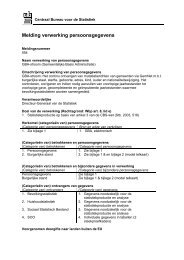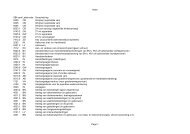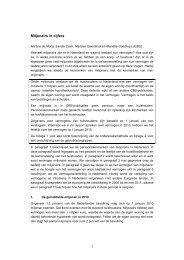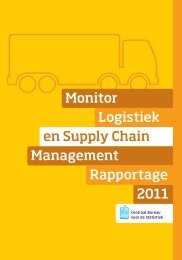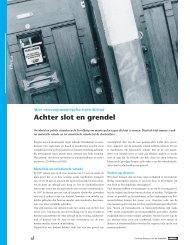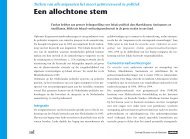Methoden voor de berekening van de emissies door mobiele ... - CBS
Methoden voor de berekening van de emissies door mobiele ... - CBS
Methoden voor de berekening van de emissies door mobiele ... - CBS
Create successful ePaper yourself
Turn your PDF publications into a flip-book with our unique Google optimized e-Paper software.
Recreational boat traffic<br />
The emissions are calculated by multiplying the explanatory variables for emissions, the number of<br />
recreational boats (allocated to open motor boats/cabin motor boats and open sailboats/cabin<br />
sailboats) with the average fuel consumption per boat type times the emission factor per substance,<br />
expressed in emission per engine type per quantity of fuel. The various types of boats are equipped<br />
with a specific allocation of engine types that <strong>de</strong>termine the level of the emission factors.<br />
The emission factors are measured in quantities of emission per quantity of generated kinetic energy.<br />
By dividing them with the specific fuel consumption (fuel quantity required per unit of generated kinetic<br />
energy), an emission factor per quantity of fuel is obtained.<br />
For the water emissions, the calculations are <strong>de</strong>scribed in the fact sheet "engine emissions of<br />
recreational boat traffic" [ref 108: RWS-Waterdienst, 2005]. The air-contaminating emissions from<br />
recreational boat traffic are also inclu<strong>de</strong>d in this fact sheet.<br />
The emission factors for macro-components (in grams/kg fuel) for recreational boats with petrol and<br />
diesel engines are shown in Tables 2.1 through 2.6.<br />
Combustion of motor fuels: N2O and NH3<br />
The combustion emissions within the Netherlands of N2O and NH3 are calculated using the IPCC<br />
<strong>de</strong>faults for N2O [ref 68: IPCC, 1997] and the emission factors of the EEA for NH3 [ref 60: Ntziachristos and<br />
Samaras, 2000] (Table 2.6). These emission factors are multiplied by the total fuel consumption of inland<br />
navigation in the Netherlands.<br />
Combustion of motor fuels: VOC and PAH components and heavy metals<br />
The calculation of the combustion emissions of VOC and PAH components, including methane, takes<br />
place using profiles. First, as <strong>de</strong>scribed in Section 1.4.1, the combustion emissions of VOC are<br />
calculated. The profiles indicate the fractions of the various VOC and PAH components in this "total"<br />
VOC. By multiplying total VOC emissions with the fractions from these profiles, the emissions of<br />
individual VOC and PAH components are estimated.<br />
The emissions of heavy metals are calculated by multiplying the fuel consumption with the emission<br />
factors that are based on the metal content of the marine fuels. The emission factors, expressed in<br />
grams per kg of fuel, are shown in Table 2.6. The emission profiles for VOC and PAH components are<br />
shown in table 2.7.<br />
De-gassing cargo fumes to the atmosphere<br />
The calculation of the emissions (including VOC emissions) are conducted for each substance using<br />
the following formula:<br />
Weight of VOC (vapour) emitted =<br />
mass of unloa<strong>de</strong>d cargo (A) * percentage after which the hold is ventilated (B) * evaporation<br />
factor (C)<br />
The required data fall into three categories:<br />
a (A) transport data, originating from statistical information;<br />
a (B) data about the practice of loading and unloading (also linked partially to regulations);<br />
a (C) chemical and physical data, originating from the rele<strong>van</strong>t literature.<br />
In this formula, the weight of the unloa<strong>de</strong>d cargo is the explanatory variable for emissions. The<br />
emission factor is arrived at by multiplying the evaporation factor with the percentage of the unloa<strong>de</strong>d<br />
cargo after which the hold is ventilated. A comprehensive <strong>de</strong>scription of the methodology can be found<br />
in the protocol established as part of the EMS project [ref 99: Bolt, 2003].<br />
45





